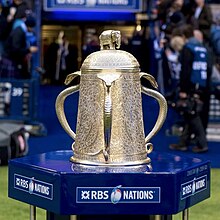Calcutta Cup
The Calcutta Cup is a trophy in the sport of Rugby Union , which every year as part of the Six Nations tournament the winner of the match between England and Scotland will be presented. The current owner of the trophy is England, who won 13: 6 at Murrayfield Stadium on February 8, 2020 .
The Calcutta Club
On Christmas Day 1872, a rugby game was played in the Indian city of Calcutta (now Kolkata ). There were 20 players from England on one side and 20 players from Scotland, Ireland and Wales on the other. The game was such a huge success that they met again a week later. These games eventually led to the founding of Calcutta Football Club in January 1873.
The Calcutta Club joined the Rugby Football Union (RFU), the English association , in 1874 . Although the Indian climate was not particularly suitable for rugby games, the number of members of the club increased. However, when the bar with the free drinks had to be closed, the association experienced a marked decline in membership. Many players turned to tennis and polo, which were less strenuous in the tropical heat. The remaining members decided to dissolve the association, but were determined not to let the association's name be forgotten. They withdrew the club's assets, which consisted of silver rupees , from the bank, melted the coins and had a trophy made from them. They presented this to the RFU in 1878, on condition that it should be played for every year.
The competition
Despite the Calcutta Club's original request to regard the cup as rugby's answer to the FA Cup , the RFU decided against hosting a cup competition for English club teams. The association believed that “competitive thinking” was against the amateur ethos of rugby. Instead, the RFU decided that an international match between England and Scotland should be played every year and that the winner should keep the trophy for a year. The first game for the Calcutta Cup took place on March 10, 1879 at Raeburn Place in Edinburgh and ended in a draw. The following year England became the first winner. Up to 2015, 133 games were played for the Calcutta Cup.
The trophy
Made in India, the cup is 18 inches (45.72 cm) high, made of silver, and is richly decorated. The three handles are shaped like king cobras . On the dome-shaped lid there is an elephant , according to tradition it is said to represent one of the animals in the possession of the viceroy at the time. The inscription on the wooden base reads: THE CALCUTTA CUP.
Additional plaques are attached to the base, on which the date of each game as well as the winning team and the names of the two team captains are recorded. Although the cup has only been played since 1879, the records on the pedestal go back to the first international match in 1871.
The original trophy is in a very fragile condition for many years due to poor handling and is no longer stable enough for use at victory celebrations. If the trophy is in English possession, it is displayed in the Rugby Museum in London's Twickenham Stadium , where it slowly rotates in a specially built display case. Both England and Scotland have true-to-scale copies made using modern technology.
In 1988 the Calcutta Cup was damaged by some drunk players playing "soccer" with it on Princes Street in Edinburgh. Then the Scottish player John Jeffrey was banned from the Scottish Rugby Union for six months, the English player Dean Richards from the RFU for a game.
